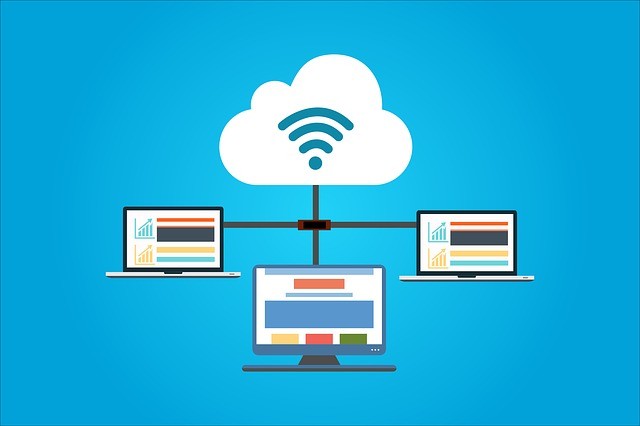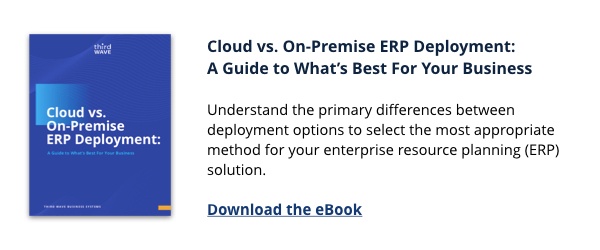…that Third Wave’s Chargeback Processing add-on meets the chargeback processing needs of businesses that sell and distribute their products to major retailers (e.g. WalMart, Home Depot, Target) regardless of industry or product type?
Watch the Chargeback Processing overview video!

Did You Know?…
Learn More
A: There are, in fact, disadvantages of cloud ERP deployment. The most common are: Security & Privacy, Dependency on your provider, Decreased Flexibility, Integration, and Cost. But, with the right Cloud ERP solution provider, you can minimize the above drawbacks and maximize the advantages of cloud deployment.

Q: Are there disadvantages associated with “going to the Cloud”?
Learn More
A: Most companies eventually come to the realization that the process they currently use is prohibiting growth. Understanding the major pain points of the current process will help you understand what products can relieve those pain points.

Q: How Do I Know What I Really Need for Systems?
Learn More
DID YOU KNOW…
Cloud computing improves organizational agility. The following characteristics and benefits of the Cloud, specifically SAP Business One OnDemand, can aid you in generating a more agile business:
- Elastic Scalability: Scale up or down according to your organizational requirements.
- Measured Service: Pay only for what your business uses with a per-tenant basis.
- On-Demand Resources: Automatically manage computing resources through your hosting provider.
- Ubiquitous Access: Run your business remotely at any time using various low-cost devices with network access.
- Resource Pooling: With multiple tenants, sharing usage and cost of common computing resources is simple because all data is stored centrally in hosted data centers.

Improve Your Business Agility With the Cloud
Learn More
To continue our conversation on Cloud computing, we want to take you to a specific example of how this can work with you and your business systems. In past posts we have introduced you to Cloud computing, discussed public vs. private Clouds, but how does all of this relate to SAP Business One? SAP has recently released their OnDemand solution which grants on-demand access to vast computing resources that are centrally managed in data centers and scale dynamically according to specific requirements. Besides a significantly lower total cost of ownership, SAP OnDemand delivers the best of both worlds; the power of the SAP Business One application and the ease-of-use and affordability of on-demand deployment.
By utilizing OnDemand, you can access Business One remotely. You can share common resources while lowering maintenance requirements, and as the number of employees in your company grows, OnDemand grows with you, providing the ideal starting point as the foundation for a successful Cloud platform.
How exactly does OnDemand work? SAP Business One is centrally hosted on servers in a data center. You can access the system by logging in through a portal in your Web browser. The application data is stored and backed up in the data center. OnDemand grants access permissions on a per-user or per-tenant basis, meaning you can only see your own data.
The following are the most significant factors of SAP Business One OnDemand:
- All functionality of Business One is still available, heightening usability.
- SAP leverages their already extensive ecosystem, ensuring that functions, like add-ons, continue to work in the Cloud with no disruptions.
- Delivers enterprise grade security and reliability, which provides a greater level of protection than is normally implemented with an on premise environment.
- Existing add-ons are certified to run in the Cloud, giving you the same benefits as if you were running in an on premise environment.
Who would use it? Business One OnDemand is a comprehensive and flexible cloud solution for small businesses with a lower total cost of ownership. It is ideal for companies who want to simplify in-house IT requirements and minimize up-front capital expenses.
What’s next? Business One OnDemand offers a low cost, Cloud-based ERP platform that enables clients to focus on their organization. Take the next step and contact Third Wave today to see if a solution like OnDemand is right for your organization!

SAP OnDemand
Learn More
A: SAP has a feature-rich Opportunities module that can be augmented by Third Wave’s Marketing Campaign Module. Since SAP has strong CRM features, making sure the flow of data from when a prospect turns into a customer is essential between the Marketing and Sales team to keep the process as efficient as possible.

Q: How can I get this software to help my Sales and Marketing teams to work better?
Learn More
“FREE” is widely considered the most powerful word when it comes to advertising. But offers that promise free goods or services are often restricted to a certain timeframe or offer something additional that customers wouldn’t necessarily want or need with the purchase.
But what if you could offer your customers the benefit of earning credits towards free goods that they DO want each time they make a purchase? And what if that offer simultaneously resulted in increased customer loyalty, increased sales, and increased customer satisfaction? Enter the Rewards Points program.
They have been around for years. Frequent Flyer miles were most likely the origin of this novel marketing tool. But the approach has been adapted to allow customers to earn everything from free gasoline to your Thanksgiving turkey. The points approach has become a staple for the credit and charge card industries, and they should know a thing or two about consumer buying habits.
But how can you incorporate a customer rewards points system into your SAP Business One system? It’s a lot easier than you might think. First, there are a few factors that you need to think about. Who will be eligible to earn and redeem points? Which items will generate points? (You may not want to add additional cost to clearance or low margin items). With the use of a single Business Partner Property and Item Property, you can manage this aspect of the system.
At several clients where we recently implemented a points system, a simple SQL view displays Pending Points (invoiced, not paid) and Available Points (paid invoices less applied points). With a User defined table, we added the ability to add manual points adjustments. And with Third Wave’s Advanced Productivity Pack, we added a summary of points information to the Business Partner window with a button that shows all Points transactions and validations that restrict how many points can be applied to an order. You can automatically calculate a Sales Order cash discount based on the amount of points being redeemed and the customers custom defined cash discount factor.
Not a whole lot of work to implement such a familiar and powerful marketing tool for your own SMB. “Points” may be giving “FREE” a run for it’s money!
-Steve Ovadia, Consultant

A Point to Consider.
Learn More
As mentioned in our previous blogs, leveraging Cloud as part of your business operations platform is not just a prudent decision but is pretty much a necessity in today’s fast-paced business environment. Going more in depth, there are two ways for you to run your business through the Cloud – privately or publicly. Understanding the differences between private and public Cloud, as well as various providers, is crucial to ensure the initiative will succeed in the long run.
Although running your business in the Cloud is extremely beneficial, there are a few factors to take into account before you make your final decision as to what type of Cloud solution to display.
First off, you may feel like you are faced with too many cloud options. And on top of that, you probably feel like if you make the wrong decision, it will hurt your company in the long run. Additionally, too many people have started to think that a “private” cloud solution is the best choice when they haven’t taken other alternatives into consideration.
You want to make a smart investment. Selecting new tools for your organization should be viewed as an investment, both in time and money. A smart investment has the power to enable your organization to be exponentially more effective and efficient. Similarly, an unwise and careless investment can seriously undermine your previous hard work. Bottom line: it is extremely important that you consider your potential partner for implementation/long-term Cloud support.
Let’s get more in depth with the specifics of private vs. public Clouds:
Private Cloud
A private Cloud is, essentially, a Cloud computing capability dedicated to one organization.
Examples:
- ExternalIT (www.externalit.com)
Public Cloud
A public Cloud refers to services (storage, applications, etc.) that are made available to the general public by a service provider. Public Cloud almost always means that the resources are being shared by multiple users or organizations.
Examples:
- Storage – Amazon S3, Skydrive, DropBox
- Documents & Collaboration – Google Docs, Office 365
- Infrastructure – Amazon Web Services, Microsoft Azure
Public Vs. Private
| Advantages | Considerations | |
| Private | Maximum control; Flexible; high level of integration; Run any application | Accommodate all needs |
| Public | Lower cost; Easy & Quick setup; Highly scalable; | Security, Limited customization, shared resources; May need multiple Clouds |
Questions to keep in the back of your mind while considering providers:
- Vendor details: find out about the specific vendor, their sustainability, product reviews?
- Do they own the infrastructure or do they resell services?
- Data access policies and security – who “owns” the data?
- Data portability: will you be able to move your data should you choose to change providers down the road? Will you be charged a termination fee?
By taking the time upfront to carefully consider your potential Cloud-computing partner, you will inadvertently reap the benefits of the best possible result. Contact Third Wave to see what type of cloud solution, private or public, would be most favorable to your company.
-Gopal Viswanathan, Director of Software Development

Public vs. Private Cloud – Which Works Best For You?
Learn More
